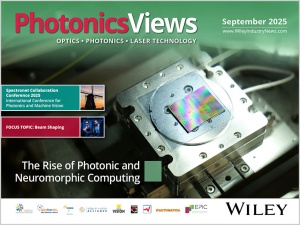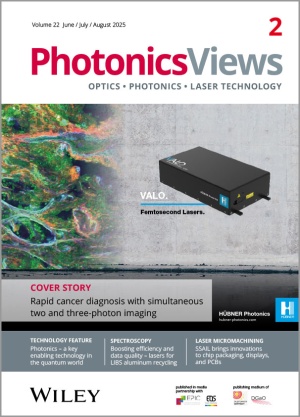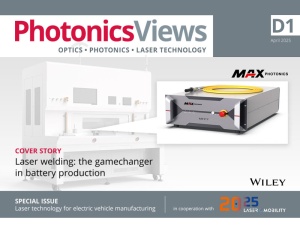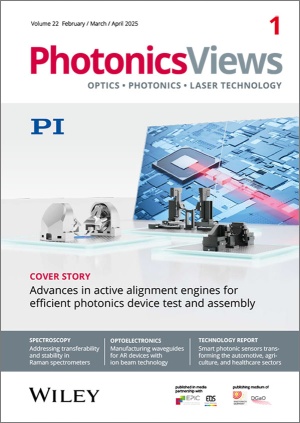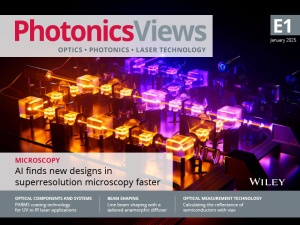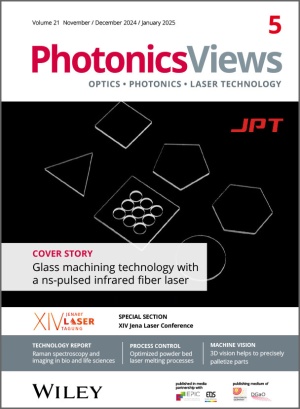Resilient laser cladding with a high-power laser, wire and powder creates efficient, fast, and sustainable coatings for industrial components, developed within project HICLAD. (Source: Fh. IWS / ronaldbonss.com)
p. 37
Ausgabe lesen
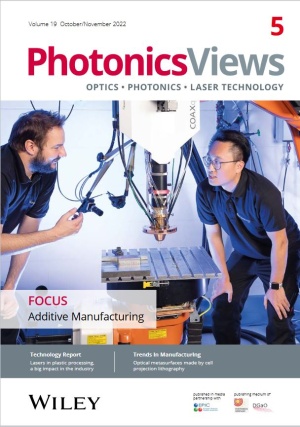
Resilient laser cladding with a high-power laser, wire and powder creates efficient, fast, and sustainable coatings for industrial components, developed within project HICLAD. (Source: Fh. IWS / ronaldbonss.com)
p. 37
EPIC's photonics technology manager Panagiotis Vergyris talked with David Ruppel, president of IDEX Optical Technologies, a specialist in the design, assembly, and coating of complex optical systems for the semicon, defense, industrial, and space markets.
Physik Instrumente (PI) got through the Corona pandemic well, in spite of all the difficulties. Very well, in fact. Just how the manufacturer of positioning technology was able to grow during the crisis is explained by its chief executive officer Markus Spanner and its chief sales officer Stéphane Bussa in an interview.
Tribological coatings effectively protect heavily stressed components against wear and reduce friction. Oven processes are usually used to produce these coatings. In these processes, the substrate is subjected to an increased thermal load, whereby it must be accepted that mixing of the individual layers occurs.
Plastic materials continue to be of great importance for a large number of industries. Environmental regulations are moving towards the reduction and control of their presence in the market to avoid an increase in waste, but their properties have made them the preferred material for numerous applications. The use of lasers in industrial applications has been extended to the processing of this family of materials due to their advantages when cutting, marking, drilling or welding these components.
Mathias Hädrich, Thomas Siefke, Michael Banasch, Uwe D. Zeitner
Metasurfaces offer promising possibilities for emerging photonic applications like see-through, near-eye displays. Vistec Electron Beam lithography systems with variable shaped beam (VSB) and cell projection (CP) technology provide a flexible solution to generate repetitive structures on large substrates. Excellent pattern fidelity is achieved in a feasible write-time, enabling prototyping or the manufacturing of replication masters.
For many years, the main use of lasers was in the sciences. They were used primarily in spectroscopy, measurement technology, and nuclear physics. With the invention of the diode laser, they began to be used in everyday applications ranging from CD players to communications technology. Ever-increasing performance has long since opened up further applications. For example, lasers can now even cut centimeter-thick sheet steel.
UpNano combined their additive manufacturing system NanoOne with Ansys Zemax' virtual prototyping technologies to help companies optimize polymer lens development and achieve high-resolution precision at an unprecedentedly tiny scale. The high-powered lasers and data-driven system design enhancements yielded rapid fabrication techniques at the nano, micro, meso, and macro range.
Large-scale additive manufacturing (LSAM) is an additive manufacturing process based on the principles of fused filament fabrication but with significantly higher material deposition rates. The novel hybrid process shown in this paper combines LSAM with a laser beam heat treatment. The structure and mechanical properties of parts are improved due to significantly decreased void sizes. The following article details investigations into the vertical and lateral remelting of strands as well as the utilization of a mirror system, which enables beam guidance according to the machine's printing path.
Michel Layher, Jens Bliedtner, René Theska
Large-scale additive manufacturing (LSAM) is an additive manufacturing process based on the principles of fused filament fabrication but with significantly higher material deposition rates. The novel hybrid process shown in this paper combines LSAM with a laser beam heat treatment. The structure and mechanical properties of parts are improved due to significantly decreased void sizes. The following article details investigations into the vertical and lateral remelting of strands as well as the utilization of a mirror system, which enables beam guidance according to the machine's printing path.
Cailabs have designed a reconfigurable beam shaper dedicated to the laser powder bed fusion process that is able to produce an ellipse, ring or round top-hat beam profile in the processing plane. This study highlights the potential of beam shaping to improve the quality and productivity of the additive manufacturing process. Using a machine which was not initially able to print Inconel 939, the round top-hat shape made it possible with a large scan speed process window.
Alexander Brodsky, Natan Kaplan
Ultrashort-pulse (USP) lasers enable microlevel manipulation of material surfaces and work on the bulk of transparent materials with almost no thermal effects. One major bottleneck that is limiting the processing speed with USP lasers is the effective spreading of laser energy in the processed material. Diffractive optical elements (DOE) are a leading method of solving this bottleneck. In this article, we review the concept of 3D diffractive light shaping for USP lasers and show its usefulness in various industrial USP laser applications.
Despite the rapid development of modern lasers, the Gaussian intensity distribution often leads to problems, especially in laser material processing. When welding wide weld seams, a top-hat profile would often make much more sense in order to heat the weld seam as homogeneously as possible. In narrow curves, the different feed rates on the inside and outside of a wide weld seam result in further inhomogeneity. For this reason, a special optical system was developed that delivers homogeneous intensity distribution – both in straight lines and in narrow curves. The intensity distribution of a wide top-hat profile can be changed locally and temporally by nine parallel beams. The welding head is installed on a robotic arm that travels along the weld seam and temperature homogeneity of >90 % within the spot can be achieved.


